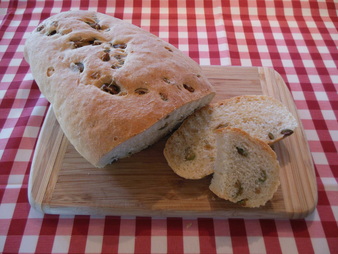Olive Bread

One of my mother's favorite stories about my childhood idiosyncrasies involves olives. When I was a young adult she would often remind me that as a first grader, I would take the money my grandfather Domenico gave me for weeding the sidewalk in front of the house and run to the corner grocery store and buy olives. Well, it was a different era then. But, I still love olives and would probably still choose them over any number of snack foods. Pairing olives with bread is almost the perfect combination for me.
When I contemplated making an olive bread, I wanted to make a bread that was as simple as the one my Italian family made from flour, water, salt and yeast. It was a bread of the peasants that did not include eggs, olive oil and a number of other ingredients that appear in many bread recipes. So, I started with the same basic ingredients that my family used and added green olives. Green olives are generally firmer than black olives and I think work better in breads, but you could substitute black olives if you prefer.
Ingredients
3/4 cups and 2 tablespoons of lukewarm water
1 package dry yeast
3 cups of flour for bread
approximately 1/2 tsp. salt
18 to 24 large green olives coarsely chopped
olive oil for oiling the bowl
Equipment
Kitchenaid mixer with dough hook
Baking sheet covered with parchment paper
To make the Olive Bread
Oven temperature: 400 degrees F (200 C)
Step 1: Warm the water. Microwaves differ significantly in power, but with mine if I warm the water for 25 seconds it is just about perfect. Pour the water into the bowl of your mixer and sprinkle the yeast over the water. Let it sit for about 10 to 15 minutes until it proofs and bubbles are rising to the surface.
Step 2: Add the flour and salt to taste (about 1/2 teaspoon, less if the olives are really salty) and mix with the dough hook until the water is absorbed and it begins to form a ball.
Step 3: Remove the dough from the bowl and work it to form a ball.
Step 4: On a floured surface, knead the dough for 10 minutes. It will become smooth and elastic in texture.
Step 5: Form the dough into a ball and place it in an oiled bowl. Cover the bowl with a damp towel and sit in a draft free place.
Step 6: Let the dough rise to at least double its size. This will probably take about 1 1/2 hours, but, this depends on the ambient temperature.
Step 7: Punch down the dough
Step 8: Lightly flour a surface where you will again knead the dough slightly. Sprinkle the olives over the floured surface and work the olives into the dough as you knead it. This will take about 3 to 5 minutes.
Step 9: Shape the dough into a loaf (or round if you prefer) and put it on the prepared baking sheet.
Step 10: Cover the dough and set it aside to rise again for 20 to 30 minutes.
Step 11: When the dough has risen for a second time, place the baking sheet in the center of the oven preheated and bake for approximately 35 to 40 minutes until it is golden brown.
Step 12: Remove from the oven and let it cool before serving.
When I contemplated making an olive bread, I wanted to make a bread that was as simple as the one my Italian family made from flour, water, salt and yeast. It was a bread of the peasants that did not include eggs, olive oil and a number of other ingredients that appear in many bread recipes. So, I started with the same basic ingredients that my family used and added green olives. Green olives are generally firmer than black olives and I think work better in breads, but you could substitute black olives if you prefer.
Ingredients
3/4 cups and 2 tablespoons of lukewarm water
1 package dry yeast
3 cups of flour for bread
approximately 1/2 tsp. salt
18 to 24 large green olives coarsely chopped
olive oil for oiling the bowl
Equipment
Kitchenaid mixer with dough hook
Baking sheet covered with parchment paper
To make the Olive Bread
Oven temperature: 400 degrees F (200 C)
Step 1: Warm the water. Microwaves differ significantly in power, but with mine if I warm the water for 25 seconds it is just about perfect. Pour the water into the bowl of your mixer and sprinkle the yeast over the water. Let it sit for about 10 to 15 minutes until it proofs and bubbles are rising to the surface.
Step 2: Add the flour and salt to taste (about 1/2 teaspoon, less if the olives are really salty) and mix with the dough hook until the water is absorbed and it begins to form a ball.
Step 3: Remove the dough from the bowl and work it to form a ball.
Step 4: On a floured surface, knead the dough for 10 minutes. It will become smooth and elastic in texture.
Step 5: Form the dough into a ball and place it in an oiled bowl. Cover the bowl with a damp towel and sit in a draft free place.
Step 6: Let the dough rise to at least double its size. This will probably take about 1 1/2 hours, but, this depends on the ambient temperature.
Step 7: Punch down the dough
Step 8: Lightly flour a surface where you will again knead the dough slightly. Sprinkle the olives over the floured surface and work the olives into the dough as you knead it. This will take about 3 to 5 minutes.
Step 9: Shape the dough into a loaf (or round if you prefer) and put it on the prepared baking sheet.
Step 10: Cover the dough and set it aside to rise again for 20 to 30 minutes.
Step 11: When the dough has risen for a second time, place the baking sheet in the center of the oven preheated and bake for approximately 35 to 40 minutes until it is golden brown.
Step 12: Remove from the oven and let it cool before serving.
